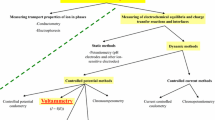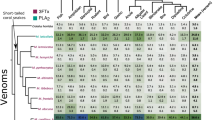Summary
-
1.
The inotropic and electrophysiological effects of aconitine were measured in the isolated, isometrically contracting guinea-pig papillary muscle during the prearrhythmic phase of alkaloid action.
-
2.
In muscles stimulated continually at 1 Hz, 1 μmol/l aconitine produced a positive inotropic effect that reached 38±(SEM) 9% immediately before the onset of arrhythmia (n=3).
-
3.
If aconitine (0.5 μmol/l) was applied to non-stimulated (resting) muscles for 30 min and 1-Hz stimulation resumed thereafter, the arrhythmia occurred after 724±101 beats. Prolongation of the rest exposure to 2 h did not significantly diminish the number of prearrhythmic beats. Thus, the onset of aconitine action is critically determined by muscle activity (rather than by time), and a 30-min aconitine application to the resting muscle suffices for complete equilibration of the tissue.
-
4.
Using the preequilibration-at-rest procedure, the positive inotropic effect of aconitine (0.25–4 μmol) was found (a) to be absent in the rested-state contraction, (b) to grow with both number of subsequent beats and alkaloid concentration, and (c) to reach a similar prearrhythmic maximum at all concentrations. This maximum amounted to about 1/4 of the maximum positive inotropic effect of dihydroouabain. It was not influenced by reserpine pretreatment of the guinea pig.
-
5.
Aconitine (1 μmol/l) delayed the repolarization phase of the action potential by establishing a secondary plateau at approximately −60 mV. This effect paralleled the positive inotropic effect and, like the positive inotropic effect, was abolished by 10 μmol/l tetrodotoxin (TTX). In partially depolarized muscles ([K]0=24 mmol/l) aconitine (8 μmol/l) produced a TTX-sensitive increase in amplitude and rate of rise of the rested-state contraction; this indicates a voltagedependent effect on some resting Na channels.
-
6.
While delaying thelate repolarization phase, aconitine markedly shortened theearly repolarization at levels positive to −40 mV, reduced the overshoot and decreased the maximum rate of depolarization of the action potential. Slow action potentials ([K]0=24 mmol/l; 10 μmol/l TTX) were insensitive to aconitine.
-
7.
We conclude that the well known property of aconitine to prolong the Na influx during the action potential leads to a positive inotropic effect, thus confirming the importance of Na influx for the regulation of myocardial contractility. The exact mechanism of an additional effect by which aconitine reduces the overshoot and shortens the plateau phase of the action potential awaits further study.
Similar content being viewed by others
References
Catterall WA (1980) Neurotoxins that act on voltage-sensitive sodium channels in excitable membranes. Ann Rev Pharmacol Toxicol 20:15–43
Catterall WA, Coppersmith J (1981) Pharmacological properties of sodium channels in cultured rat heart cells. Mol Pharmacol 20:533–542
Cohen CJ, Fozzard HA, Sheu S-S (1982) Increase in intracellular sodium ion activity during stimulation in mammalian cardiac muscle. Circ Res 50:651–662
Heistracher P, Pillat B (1962) Elektrophysiologische Untersuchungen über die Wirkung von Chinidin auf die Aconitinvergiftung von Herzmuskelfasern. Naunyn-Schmiedebergs Arch Exp Path Pharmak 244:48–62
Honerjäger P (1983) Cardioactive substances that prolong the open state of sodium channels. Rev Physiol Biochem Pharmacol 92:1–74
Honerjäger P (1983) Ceveratrum alkaloids: progress in understanding their membrane and inotropic actions. Trends Pharmacol Sci (in press)
Honerjäger P, Reiter M (1975) The relation between the effects of veratridine on action potential and contraction in mammalian ventricular myocardium. Naunyn-Schmiedeberg's Arch Pharmacol 289:1–28
Honerjäger P, Reiter M (1977) The cardiotoxic effect of batrachotoxin. Naunyn-Schmiedeberg's Arch Pharmacol 299:239–252
Honerjäger P, Frelin C, Lazdunski M (1982) Actions, interactions, and apparent affinities of various ceveratrum alkaloids at sodium channels of cultured neuroblastoma and cardiac cells. Naunyn-Schmiedeberg's Arch Pharmacol 321:123–129
Katzung BG (1982) Myocardial toxicity as the result of altered membrane channel function. In: Van Stee EW (ed) Cardiovascular toxicology. Raven Press, New York, pp 135–179
Langer GA (1982) Sodium-calcium exchange in the heart. Ann Rev Physiol 44:435–449
Lazdunski M, Renaud JF (1982) The action of cardiotoxins on cardiac plasma membrane. Ann Rev Physiol 44:463–473
Matsuda K, Hoshi T, Kameyama S (1959) Effects of aconitine on the cardiac membrane potential of the dog. Jpn J Pharmacol 9:419–429
Meissner A, Honerjäger P (1982) Positive inotropic effect of aconitine. Naunyn-Schmiedeberg's Arch Pharmacol (Abstract) 319:R39
Morad M, Trautwein W (1968) The effect of the duration of the action potential on contraction in the mammalian heart muscle. Pflügers Arch 299:66–82
Mozhayeva GN, Naumov AP, Negulyaev YA, Nosyreva ED (1977) The permeability of aconitine-modified sodium channels to univalent cations in myelinated nerve. Biochim Biophys Acta 466: 461–473
Mullins LJ (1981) Ion transport in heart. Raven Preess, New York
Peper K, Trautwein W (1967) The effect of aconitine on the membrane current in cardiac muscle. Pflügers Arch 296:328–336
Reiter M (1966) Der Einfluß der Natriumionen auf die Beziehung zwischen Frequenz und Kraft der Kontraktion des isolierten Meerschweinchenmyokards. Naunyn-Schmiedeberg's Arch Pharmacol 254:261–286
Reiter M (1967) Die Wertbestimmung inotrop wirkender Arzneimittel am isolierten Papillarmuskel. Arzneimittelforsch 17:1249–1253
Reiter M (1982) Inotropic cardiac effects mediated by intracellular sodium. In: Yoshida H, Hagihara Y, Ebashi S (eds) Advances in pharmacology and therapeutics II, vol 3. Pergamon Press, Oxford New York, pp 195–204
Romey G, Lazdunski M (1982) Lipid-soluble toxins thought to be specific for Na+ channels block Ca2+ channels in neuronal cells. Nature 297:79–80
Scherf D, Schott A (1973) In: Extrasytoles and allied arrhythmias, 2nd ed. Year Book Publishers, Chicago, pp 744–746
Schmidt H, Schmitt O (1974) Effect of aconitine on the sodium permeability of the node of Ranvier. Pflügers Arch 349:133–148
Schmidt RF (1960) Versuche mit Aconitin zum Problem der spontanen Erregungsbildung im Herzen. Pflügers Arch 271:526–536
Tanz RD, Robbins JB, Kemple KL, Allen PA (1973) Pharmacology of aconitine-induced automaticity of cat papillary muscle. I. Effect of dose, tension, rate and endogenous catecholamines. J Pharmacol Exp Ther 185:427–437
Winslow E (1981) Hemodynamic and arrhythmogenic effects of aconitine applied to the left atria of anesthetized cats. Effects of amiodarone and atropine. J Cardiovasc Pharmacol 3:87–100
Yuryavichyus IA, Rozenshtraukh LV, Yushmanova AV (1980) Formation of ectopic excitation in the heart under the effect of aconitine. Communication I. Dynamics of input and output membrane currents. Kardiologiya 20:75–78
Author information
Authors and Affiliations
Additional information
This work will be included in the thesis of A. Meissner, Technische Universität München
Rights and permissions
About this article
Cite this article
Honerjäger, P., Meissner, A. The positive inotropic effect of aconitine. Naunyn-Schmiedeberg's Arch. Pharmacol. 322, 49–58 (1983). https://doi.org/10.1007/BF00649352
Received:
Accepted:
Issue Date:
DOI: https://doi.org/10.1007/BF00649352




